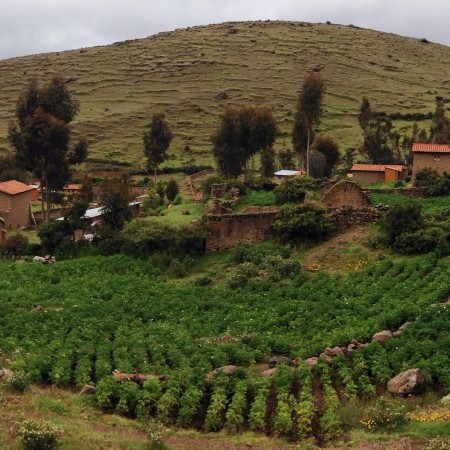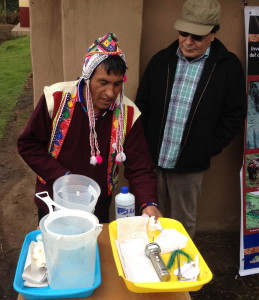- Where should we collect sweet potato wild relatives?
- Cheese made from toe bacteria. Because we can.
- The sainted M.S. Swaminathan on millets.
- FAO brings together dietary guidelines from around the world.
- An infographic on kale origins.
- Diversity down, productivity down. At least in Alaska.
- Cotton’s got a genome.
- McDonalds commits to ending deforestation in its supply chain.
- IUCN report says commercial agriculture and forestry could could actually be good for biodiversity. Hope McDonalds read it.
Nibbles: SDGs, Seed book, Magic millets, Medieval diets, Obsessive botanist, Cocoa melting gene, Double sake, Simcock, CIMMYT double, Popular breeder, Georgian wine odyssey, Cinnamon vid, Yam bean factsheet, Jackfruit bandwagon, Prairie berries
- Agriculture and the SDGs in one nice infographic thingy.
- Seeds: The Book.
- Seeds like millets?
- Those medievals really knew how to eat.
- An obsessive botanist? Whatever next.
- Deconstructing chocolate, one gene at a time.
- Sake 101. And for a more in-depth look…
- Joseph Simcox, self-described “Internationally Renowned World Food Plant Resource Authority” takes you “on a World Adventure to learn about little known edible plants!” On Facebook.
- A journey into the heart of CIMMYT. They’ll even screen your maize for you.
- The people’s breeder.
- Tracing wine to its source: Georgia.
- Harvesting cinnamon. With video goodness.
- FAO unleashes its mighty comms machine on another poor neglected crop: yam bean. Not many people hurt.
- Watch out jackfruit, you’re probably next.
- Or maybe saskatoon berries (Amelanchier alnifolia).
Nibbles: Svalbard double, AgAtlas upgrade, Ornamental database, Wild apples, Genetic garden, Sandalwood trade, Amazon dams, Body bacteria, ICRISAT blog, African greens, Aquatic camel, Mujer empowerment
More of a proper catch-up Nibbles later, but these should hold you for a while.
- Le Figaro goes to Svalbard.
- But Wired goes into much more depth on the tragic situation in Syria.
- Many AgAtlas pages now include interactive mapping and data download, eg AEZ. About time :)
- Looking for information on varieties of ornamental plants? Look no further.
- Diversity in wild European apples: past, present and future.
- Genetic garden opens in Bangalore.
- The perils of sandalwood smuggling.
- Dam the Amazon, full speed ahead! What will happen to all that human body bacteria diversity?
- ICRISAT’s new DG has a blog. Looking forward to his first foray into the genebank.
- Lots of stuff on African traditional veggies in AVRDS’s latest newsletter.
- The swimming camels of Gujarat get protection. I’d pay money to see them, I really would.
- Patagonian women farmers are doing it for themselves, at last.
Nibbles: Old date, Cassava genomic selection, Citizen science double, Cover crops, Quinoa boom, Sorghum boom, Teff boom, Gluten, Malnutrition roundup, African veggies, Farmer2farmer, Double chocolate
- That 2000-year old date palm seed is all grown up.
- And since we’re talking ancient stuff: ornithology in the service of egyptology.
- Citizen scientists track phenology.
- Citizen scientists find new species.
- Let’s hear it for cover crops.
- Turns out it’s ok for hipsters to eat quinoa.
- Sorghum takes over the Great Plains. (Well, not really.) And not only… Who needs quinoa.
- Especially when you have teff.
- And while we’re on gluten: need to make up for that off-colour quip in the last Nibbles.
- Malnutrition. Mapped. Including that much-discussed Missing Middle? Hang on, wait, here’s another nutrition mapping thing.
- African leafy greens in Benin get a video. Map that!
- Farmers make good extensionists.
- Chocolate workshops at Kew.
- Caribbean chocolate to get a make-over. Somebody telling Kew?
Complementary potato conservation in the Parque de la Papa
 I was in South America for the past couple of weeks, which is why blogging has been, well, slow. One of the places I visited was the Parque de la Papa, or Potato Park, near Cusco in Peru, thus fulfilling a long-standing ambition. The Parque brings together six local communities around the imperative to conserve local potato diversity, both wild and cultivated, and use it sustainably. They raise money through ecotourism, including a restaurant serving local delicacies, but also through action research projects. One of the more important things that’s been happening is the “repatriation” of virus-free landraces from the genebank of the International Potato Centre (CIP), including with support from the International Treaty.
I was in South America for the past couple of weeks, which is why blogging has been, well, slow. One of the places I visited was the Parque de la Papa, or Potato Park, near Cusco in Peru, thus fulfilling a long-standing ambition. The Parque brings together six local communities around the imperative to conserve local potato diversity, both wild and cultivated, and use it sustainably. They raise money through ecotourism, including a restaurant serving local delicacies, but also through action research projects. One of the more important things that’s been happening is the “repatriation” of virus-free landraces from the genebank of the International Potato Centre (CIP), including with support from the International Treaty.
 CIP staff have also been training local people in the production of botanical seed, as part of a project implemented by the Asociación ANDES with support from the Global Crop Diversity Trust. The seed is being stored in a community genebank, but will be safety duplicated at CIP, and hopefully also eventually in Svalbard. The photo shows Pedro doing a demonstration of how seeds are extracted from fruits for storage. The guy on the right is Alejandro Argumedo of ANDES. Really good to see ex situ and on farm conservation working together and complementing each other, as they should.
CIP staff have also been training local people in the production of botanical seed, as part of a project implemented by the Asociación ANDES with support from the Global Crop Diversity Trust. The seed is being stored in a community genebank, but will be safety duplicated at CIP, and hopefully also eventually in Svalbard. The photo shows Pedro doing a demonstration of how seeds are extracted from fruits for storage. The guy on the right is Alejandro Argumedo of ANDES. Really good to see ex situ and on farm conservation working together and complementing each other, as they should.